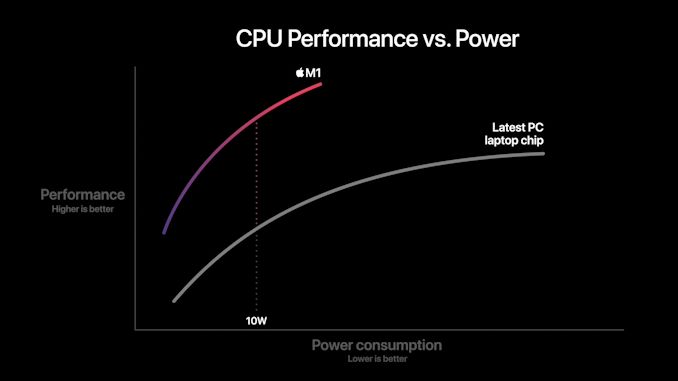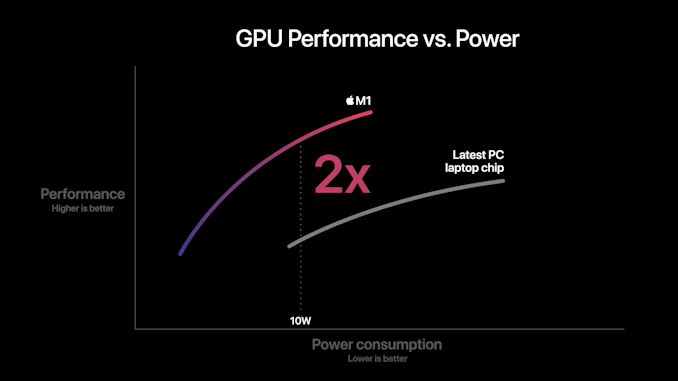Apple Announces The Apple Silicon M1: Ditching x86 - What to Expect, Based on A14
by Andrei Frumusanu on November 10, 2020 3:00 PM EST- Posted in
- Apple
- Apple A14
- Apple Silicon
- Apple M1
Apple Shooting for the Stars: x86 Incumbents Beware
The previous pages were written ahead of Apple officially announcing the new M1 chip. We already saw the A14 performing outstandingly and outperforming the best that Intel has to offer. The new M1 should perform notably above that.
We come back to a few of Apple’s slides during the presentations as to what to expect in terms of performance and efficiency. Particularly the performance/power curves are the most detail that Apple is sharing at this moment in time:
In this graphic, Apple showcases the new M1 chip featuring a CPU power consumption peak of around 18W. The competing PC laptop chip here is peaking at the 35-40W range so certainly these are not single-threaded performance figures, but rather whole-chip multi-threaded performance. We don’t know if this is comparing M1 to an AMD Renoir chip or an Intel ICL or TGL chip, but in both cases the same general verdict applies:
Apple’s usage of a significantly more advanced microarchitecture that offers significant IPC, enabling high performance at low core clocks, allows for significant power efficiency gains versus the incumbent x86 players. The graphic shows that at peak-to-peak, M1 offers around a 40% performance uplift compared to the existing competitive offering, all whilst doing it at 40% of the power consumption.
Apple’s comparison of random performance points is to be criticised, however the 10W measurement point where Apple claims 2.5x the performance does make some sense, as this is the nominal TDP of the chips used in the Intel-based MacBook Air. Again, it’s thanks to the power efficiency characteristics that Apple has been able to achieve in the mobile space that the M1 is promised to showcase such large gains – it certainly matches our A14 data.
Don't forget about the GPU
Today we mostly covered the CPU side of things as that’s where the unprecedented industry shift is happening. However, we shouldn’t forget about the GPU, as the new M1 represents Apple’s first-time introduction of their custom designs into the Mac space.
Apple’s performance and power efficiency claims here are really lacking context as we have no idea what their comparison point is. I won’t try to theorise here as there’s just too many variables at play, and we don’t know enough details.
What we do know is that in the mobile space, Apple is absolutely leading the pack in terms of performance and power efficiency. The last time we tested the A12Z the design was more than able to compete and beat integrated graphics designs. But since then we’ve seen more significant jumps from both AMD and Intel.
Performance Leadership?
Apple claims the M1 to be the fastest CPU in the world. Given our data on the A14, beating all of Intel’s designs, and just falling short of AMD’s newest Zen3 chips – a higher clocked Firestorm above 3GHz, the 50% larger L2 cache, and an unleashed TDP, we can certainly believe Apple and the M1 to be able to achieve that claim.
This moment has been brewing for years now, and the new Apple Silicon is both shocking, but also very much expected. In the coming weeks we’ll be trying to get our hands on the new hardware and verify Apple’s claims.
Intel has stagnated itself out of the market, and has lost a major customer today. AMD has shown lots of progress lately, however it’ll be incredibly hard to catch up to Apple’s power efficiency. If Apple’s performance trajectory continues at this pace, the x86 performance crown might never be regained.












644 Comments
View All Comments
Andrei Frumusanu - Tuesday, November 10, 2020 - link
But Apple literally DID test the newest chips:https://www.apple.com/mac/m1/
"Our high‑performance core is the world’s fastest CPU core when it comes to low‑power silicon.3"
"Comparison made against latest‑generation high‑performance notebooks commercially available at the time of testing. Performance tests are conducted using specific computer systems and reflect the approximate performance of MacBook Pro."
chlamchowder - Wednesday, November 11, 2020 - link
No doubt it does well in a low power envelope. However for desktops, it's not particularly relevant when Zen 3 can win in a power envelope that's still very acceptable and easy to cool.mesahusa - Wednesday, November 11, 2020 - link
They literally state on their website that they tested against currently offered MacBook CPUs. People like you are arguing in bad faith when you wheel out "bEtTeR CoMpArEd To WhO?", as if Apple hasn't *always* referred to their price offerings from the previous generation when making claims about new products. When Apple says that the new iPhone screen is 20% brighter, do you think to yourself, "20% bRiGhTeR tHaN wHaT? a HoLe? luuuul". And EVEN if that were true, and they were comparing to something like kabylake or coffeelake, it would still be an astronomical leap. Intel has seen a measly 5-10% improvement YoY, and while AMD has now surpassed Intel, they aren't even in a ballpark in the perf/watt that Apple is providing.vais - Wednesday, November 11, 2020 - link
Benmarks what? Performance/watt or absolute performance?unclevagz - Tuesday, November 10, 2020 - link
*Testing conducted by Apple in October 2020 using preproduction MacBook Air systems with Apple M1 chip and 8-core GPU, as well as production 1.2GHz quad-core Intel Core i7-based MacBook Air systems, all configured with 16GB RAM and 2TB SSD. *Last time I checked, the only quad core MBA Apple has been selling uses Ice Lake...
repoman27 - Wednesday, November 11, 2020 - link
Correct. The 13-inch MBP with two Thunderbolt 3 ports that the new M1 version replaces was using an Apple exclusive Coffee Lake 4+3e though. The Ice Lake models with four Thunderbolt 3 ports are still available.M1 is Apple’s answer to Intel’s Y and 15W U series chips. It has not supplanted 28W U or 45W H in MacBook Pros or 65W H in the Mac mini.
Luminar - Wednesday, November 11, 2020 - link
X86 will always be better than ARM in the high end, as in 95 watt and above.chlamchowder - Wednesday, November 11, 2020 - link
Not necessarily. It doesn't have anything to do with instruction set.But right now Intel and AMD have expertise at hitting higher performance/power targets than ARM manufacturers. And ARM people have experience in the opposite (lower power targets).
misan - Wednesday, November 11, 2020 - link
As others have said, Apple's marketing is largely irrelevant at this point, since we have some independent data to raw from. But even if we accept the fact that they compare agains a 2018 MBP.... it doesn't change anything. The performance increase between Skylake and Ice Lake is meager at best. The M1 will outperform Tiger Lake with a very healthy margin, while being more power efficient, and this is what is relevant here.5j3rul3 - Tuesday, November 10, 2020 - link
Great Revolution👍👍👍